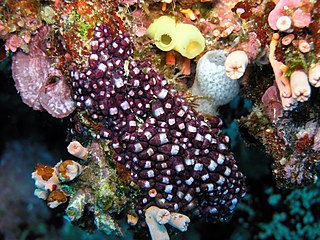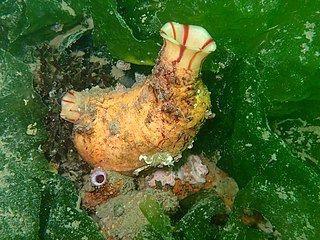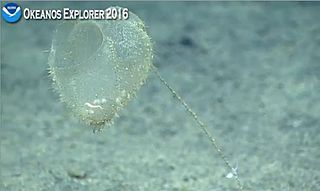
Herdmania is a genus of ascidian tunicates in the family Pyuridae.

Pyura is a large genus of sessile ascidians that live in coastal waters at depths of up to 80 m (260 feet). Like all ascidians, Pyura are filter feeders. A few species, including Pyura chilensis are commercially fished.

Microcosmus is a genus of tunicates in the family Pyuridae, containing the following species:

Botryllus is a genus of colonial ascidian tunicates in the family Styelidae.

Clavelina is genus of sea squirts, containing the following species:

Eusynstyela is a genus of ascidian tunicates in the family Styelidae.

Phlebobranchia is an order of sea squirts in the class Ascidiacea, first described by Fernando Lahille in 1886.

Pyuridae is a family of tunicates.

Stolidobranchia is an order of tunicates in the class Ascidiacea. The group includes both colonial and solitary animals. They are distinguished from other tunicates by the presence of folded pharyngeal baskets. This provides the etymology of their name: in ancient Greek, στολίς, ίδος means the "fold" of a cloth. Stolidobranchian sea squirts are also characterized by the complete absence of an abdomen. The abdominal organs of other tunicates are instead located to one side of the pharyngeal basket in this group.

Aplidium is a genus of colonial sea squirts, tunicates in the family Polyclinidae. There are about 188 species in the genus found in shallow waters around the world.
Aplidiopsis is a genus of colonial sea squirts, tunicates in the family Polyclinidae.
Molguloides is a genus of marine tunicates.
Bathyoncus is a genus of ascidian tunicates in the family Styelidae.
Bathystyeloides is a genus of ascidian tunicates in the family Styelidae.

Distomus is a genus of ascidian tunicates in the family Styelidae.
Stolonica is a genus of ascidian tunicates in the family Styelidae.

Symplegma is a genus of ascidian tunicates in the family Styelidae.
Protomolgula is a genus of ascidian tunicates in the family Molgulidae.

Culeolus is a genus of ascidian tunicates in the family Pyuridae.
Botryllus elegans is a species of colonial ascidian tunicates in the family Styelidae. It is found in Mozambique and South Africa.












